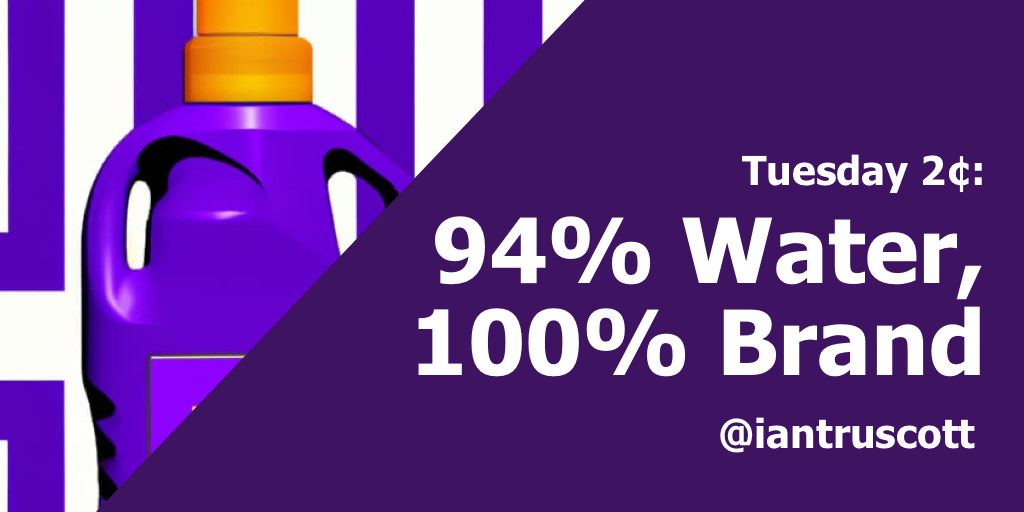Imagine if your product had no differentiation, made from a recipe mandated by federal law; why would a consumer choose it? You guessed it, this week’s topic is brand.
If you’ve read any of my Tuesday 2 cents, you’ve probably noticed that most weeks, I’m borrowing a couple of pennies from someone else. And this week, it’s the fabulous podcast by Drew Neisser, Renegade Marketers Unite and specifically episode 319 in which he chats with a brand strategist and author Lindsay Pedersen.
The topic of their conversation was the value of a brand, and Lindsay shared some of her experience working with consumer goods, specifically Clorox and the laundry category, and the thought for this week came from her sharing this:
Under federal law, Clorox is 94% water, and 6% is sodium hypochlorite. Obviously, that law doesn’t just apply to Clorox; all household bleach in the US is basically the same product.
So, essentially the commercial value, the reason people give them their hard-earned money, is entirely the brand. And Clorox as a brand generated global net sales worth approximately 7.1 billion U.S. dollars (according to Statistica).
The perception, the belief, the story that its consumers tell themselves, what they think buying this product says about them, or whatever words you use to define a brand, all of this is what “Clorox” is to their consumers, not the generic ingredients.
No secret seven spices, glass and half of milk, or a claim that it’s only 93% water compared to the competitor’s 94%. It is simply that their blend of 94% water and 6% sodium hypochlorite is what consumers (including my family when we lived in the US) choose from a brand they trust.
When people are asked about great brands, they quote Apple or Tesla, but they have a great, sexy platform for their story, maybe, let’s hear it for Clorox.
If you are in B2C or marketing consumer products, maybe that’s not so interesting. I imagine that there are many products with a similar story.
But for me, that’s a far cry from my world of B2B technology marketing, with our focus on differentiation through features, sales teams looking for silver bullets, “battle cards”, marketing that needs to redefine the category, and a general view that the product needs to be “leading”, “innovative” and well, just better in a way we can defend.
The brand is perceived as having much less marketing value than the product. It is not seen as such a driver of value and consumer choice.
Whisper this, but maybe some B2B products are the technical equivalent of 94% water, and marketing depends on the 6% being some different shit from everyone else. But imagine if that 6% is the same sodium hypochlorite as everyone else.
B2B marketers need to be innovative or leading in the stories they tell, not just rely on the product.
Especially as I suspect that B2B buyers also buy Clorox.
94% water, 100% brand.
I recommend taking a look at Drew Neissers‘s work.He’s been kind enough to be on my podcast, I have his book, and his podcast is a generous helping of B2B marketing insight.
This artwork was created with the help of Artificial Intelligence using NightCafe Creator.
Fancy more of this?
Subscribe to my Rockstar CMO Newsletter

I’m a 3xCMO, now a marketing strategy advisor and podcast host at Rockstar CMO. Although, I’m not a rock star, but a marketing leader, strategist, content marketer, columnist, speaker, industry watcher, and creator of ART (Awareness, Revenue, and Trust) for the companies I work with. But most of all, I am an enthusiastic tea drinker.
You can find me on LinkedIn, Twitter, or now Threads! – or listen to my weekly podcast at Rockstarcmo.com
The half-baked thoughts shared on this blog may not reflect those of my employer or clients, and if the topic of this article is interesting or you just want to say hello please get in touch.
